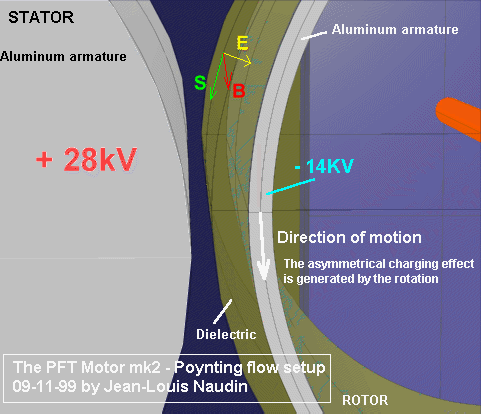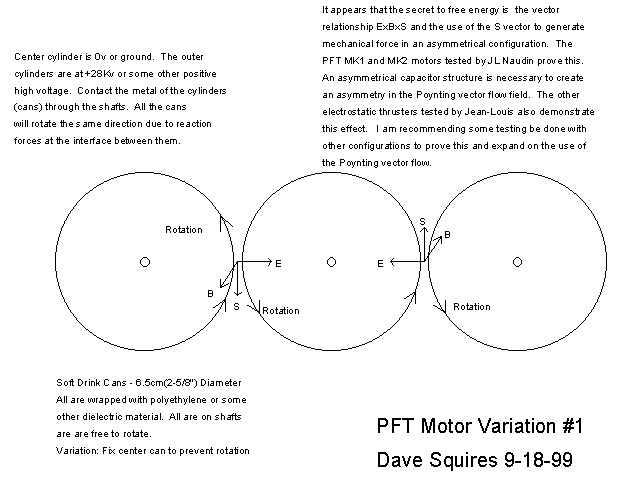
The PFT Motor
The Poynting Flow Thruster project
By Jean-Louis Naudin
created on September 20th, 1999 - JLN Labs - Last update September 20th, 1999

The PFT Motor
The Poynting
Flow
Thruster
project
By Jean-Louis Naudin
created on September 20th, 1999 - JLN
Labs - Last update September 20th, 1999
Variations on the PFT Motors of Jean-Louis Naudin by Dave Squires
It has become clear from Jean-Louis Naudin's research on asymmetrical electric fields and the Biefield-Brown effect that the primary driver is the Poynting vector. At least this is the way it appears from the models he has built to test the effects. So the breakthrough we have all been waiting for is the evidence in JL Naudin's tests that shows us how to use the Poynting vector from the vector relationship ExBxS.
For those not up on electromagnetics vector language you say this E-cross-B-cross-S. This means that all these vectors have directions orthogonal or 90 degrees from each other. You can see this from Jean-Louis' diagram.

It is simply a matter of setting up an electric field (E) and a magnetic field (B), allowing the Poynting vector (S) to be in the right direction and then stimulating or creating an asymmetry. Once you have an asymmetry derived either from the shape of the object (ARDA project) or from motion (PFT MK1, MK2 motors) you can then extract energy from the Poynting vector (S). To my knowledge his has never been done before in quite this way. The S-vector has been ignored all these years with the focus on magnetic (B) and electric field (E) vectors.
Therefore, I think that those of us that are able should initiate some independent tests of variations of these structures. Perhaps we can find the optimum structure quickly this way. I am making some suggestions based on the ExBxS vector relationship for rotating systems with the intent to find an overunity power generation system.
There are several things to be tested. I will itemize some here. If you have more ideas feel free to put them forward.
1. Focus on the ExBxS relationship and asymmetries of field structure.
Purpose: To find efficient ways to maximize the use of the S-vector
2. Set up the PFT MK2 motor to have ground or 0v on the center rotor and the two outer cylinder electrodes at +28Kv.
Purpose: Check to see if torque is increased due to two E field vectors at double the original setup.
The S-vector would be in the direction of rotation currently seen for both sides and should be twice as much giving a 4x increase in speed and torque. If it turns out to be only double the torque then it means that the S-vector flows in or out from both sides of the ExB intersection and the motion sets up the asymmetry in the required directions.
3. Add a B-field vector externally with an electromagnet or a permanent magnet.
Purpose: To see if enhancing the B-field enhances the PFT MK2 motor power output.
The B-field is weak with only 99ua in the present PFT MK2.
4. Fix the rotor of the MK2 motor and let the outer cylinder electrodes rotate.
Purpose: To check for Newtonian reaction forces related to the S-vector flow. If so then it is all relative motion and many variations are possible.
5. Allow all the cylindrical electrodes to rotate, see my drawing for this on JL Naudin's web page.
Purpose: See if multiple electrodes increases power output and how much current is used.
Also, checks the Newtonian reaction forces if all cylinders are allowed to rotate.
6. Put multiple cylinders that can rotate around a center stationary electrode and power the center at minus 28Kv or higher.
Purpose: Check for relative motion, Newtonian reaction forces, current drain on power supply, and possible application to Searl SEG type device.
7. Plot the increase in speed and power output vs voltage to see if it varies as the square of the voltage increase.
Purpose: Determine the mathematical relationship of speed, power, and voltage.
8. Make and test a variation of the Searl SEG motor using magnet rollers with a dielectric layer on the outside. The large ring would be a ring magnet with a conductive layer and then a dielectric layer on the outside. A negative voltage would be applied to the large ring conductive layer. A slight push on the rollers would be required to start it. It should be controllable by lowering or reversing the voltage polarity on the large ring.
Purpose: Test the theory that the SEG prime mover is really the S-vector and not modulated magnetic fields and that constuction can be simplified and operation controlled by E-field reduction or reversal.

The principle of ExBxS appears to be identical for the ARDA project, the PFT motors, and the Searl SEG. The vector relationships are the same for all. As a result it seems prudent to have many independent tests being done around the world. Construction is simple and testing easy. Associated costs for materials should also be low. Let's do it friends and get the world off of burning up fossil fuels. There are much better uses for oil than creating CO2, NO2, Ozone, and smog.
Dave Squires 9-19-99
See also :
The New SEG design, an enhanced Searl Effect Generator by Dave Squires
The PFT Motor mk1, the basic design.
The PFT Motor mk2, an enhanced high speed version...
![]() Email : JNaudin509@aol.com
Email : JNaudin509@aol.com
Return to the Advanced Propulsions Researches page